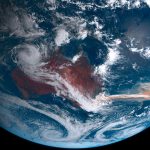 September 22, 2021 11:19 am
Published by Climate Extremes
September 22, 2021 11:19 am
Published by Climate Extremes
Variability in urban land-use results in microclimatic variability across a city that is not picked up by government weather station networks. Crowdsourced weather stations can fill these gaps.
 September 17, 2021 11:13 am
Published by Climate Extremes
September 17, 2021 11:13 am
Published by Climate Extremes
CLEX researchers and colleagues used a land-surface model that considered groundwater dynamics to explain how groundwater sustains transpiration and eases plant heat pressure during the heatwaves that occurred during the Millennium Drought and the 2017-2019 severe drought over southeast Australia.
 September 16, 2021 8:26 am
Published by Climate Extremes
September 16, 2021 8:26 am
Published by Climate Extremes
The Australian bushfires of the 2019/2020 summer had far-reaching effects. It has now been revealed in new research published in Nature that the smoke produced a phytoplankton bloom larger in area than all of Australia, thousands of kilometres away in the Southern Ocean between New Zealand and South America.
 September 9, 2021 12:41 pm
Published by Climate Extremes
September 9, 2021 12:41 pm
Published by Climate Extremes
Coral bleaching events have been reported over the Great Barrier Reef during La Niña events and the neutral phase of the El Niño–Southern Oscillation, when large-scale sea-surface temperatures may be cooler than normal. How does this occur?
 September 8, 2021 4:42 pm
Published by Climate Extremes
September 8, 2021 4:42 pm
Published by Climate Extremes
Predicting how much primary production will further increase in the Arctic Ocean in coming decades depends on the interplay between the increase in light for primary producers, as the sea ice extent and thickness decrease, and the availability of food in the form of nutrients, such as nitrate, phosphate, and silica.
 September 8, 2021 4:09 pm
Published by Climate Extremes
September 8, 2021 4:09 pm
Published by Climate Extremes
Using model simulations of the movement of tuna distributions across the tropical Pacific subject to projected ocean changes, the researchers found that without strong mitigation efforts, tuna distributions are likely to shift away from island fishing zones.
 September 3, 2021 8:51 am
Published by Climate Extremes
September 3, 2021 8:51 am
Published by Climate Extremes
It has long been suggested in the literature, and discussed casually by meteorologists, that rainfall in Melbourne often occurs as lines of precipitation. However, this had yet to be quantified. CLEX researchers analysed 15 years of radar data from the Australian Radar Archive, using an objective method to identify and track these ‘linear systems’ based on radar reflectivity, size, and shape characteristics.
 August 27, 2021 11:25 am
Published by Climate Extremes
August 27, 2021 11:25 am
Published by Climate Extremes
CLEX researchers have overturned a scientific paradigm that has existed for 50 years. New research published in Nature Geoscience shows the massive convection caused by the ocean just north of Australia, causes a chain reaction that is strong enough to put an almost permanent dent in the powerful winds that circle the Antarctic.
 August 17, 2021 10:38 am
Published by Climate Extremes
August 17, 2021 10:38 am
Published by Climate Extremes
The ocean’s much larger heat capacity acts as “memory” suppressing the atmosphere’s “high-frequency variability” (over time scales of weeks) while producing oceanic motions that vary over longer time scales. This paradigm aims to explain how low-frequency variability emerges in the ocean. But, recently, this paradigm has been challenged.
 August 2, 2021 2:54 pm
Published by Climate Extremes
August 2, 2021 2:54 pm
Published by Climate Extremes
Climate change is affecting the amount of water evaporating (from soils and surfaces) and transpiring (evaporating through plant leaves) from the land surface. Trends derived from DOLCE V3 show clear increases in ET since 1980 over the majority of the Earth’s surface.










